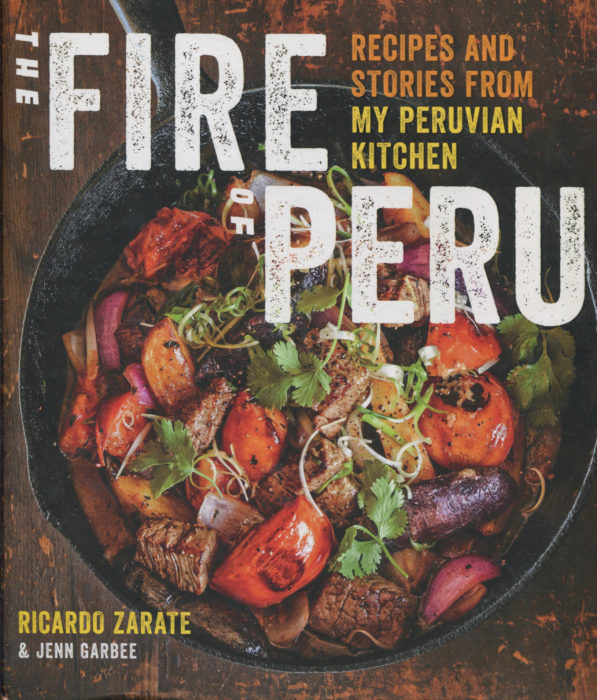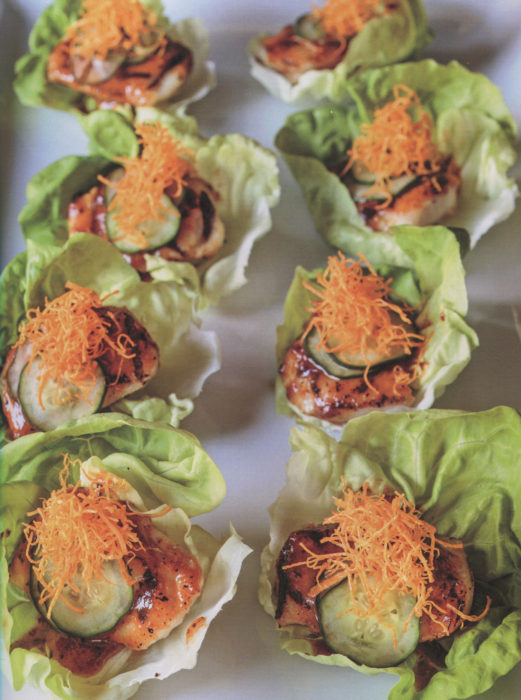
There is a very wide spectrum in the complexity of cookbooks available to us. Some are dirt simple: 3 ingredients and 20 minutes to a meal. Not necessarily a great meal. At the other extreme, 40 ingredients and three days to make a half dozen components that have to be composed into a completed dish fit for a coffee table photograph. That’s a dish you look at in the book but would never attempt at home.
If those two extremes rank from 1 to 10, then The Fire of Peru, by Ricardo Zarate, is a 7. It’s doable, and the rewards are enormous, but you’ll need a little preparation and homework. Look at the picture at the end of this post, grilled fish with honey-miso glaze cradled in lettuce wraps, and you will begin to understand the significant recipes Ricardo presents in Fire.
Ricardo is from Peru but now creates restaurants in Los Angeles. The book presents his restaurant-class recipes, meaning they have complexity in preparation and demand some artistic care in plating to achieve the full impact. You might think of Peru as a land of the Andes, but it is also a land of the Amazon. Couple that with its Pacific coastline, and you have native cuisine with an amazing spectrum of ingredients: sea, mountains and jungle.
Some of those ingredients, key ones, will not be familiar to you: aji panca, aji amarillo, and rocoto. Those are some the hot peppers native to Peru. Ricardo says that Peru is a land of thousands of pepper varieties, the land where peppers were discovered, and that those three in particular are the best. Now, someone from Mexico might dispute the origins of peppers, but the issue at hand is where do we get these three to use this book?
If you live in California or perhaps Chicago or New York City, you may well find a market with the peppers themselves on display. And you can make the pepper spreads called for in, literally, almost every recipe — even his Caesar salad dressing. Ah, but actually these peppers are really close at hand for you. You know that supermarket aisle you shoot through, the one with all the Goya products that intrigue but you don’t understand the labels and you don’t buy, that’s where the necessary ingredients are awaiting you on the shelves. Or, you can go on Amazon and find little bottles of these chili pastes for $3 to $7 dollars. The “mysterious” ingredients that Ricardo depends on can all be found.
Chapters here cover the Peruvian style of cooking and eating:
- Small Bites and Snacks
- Sushi Bar
- Grilled Vegetable, Fish, and Meat
- Stir-Fries and Stews
- From the Market: Vegetable Centric
- Grains and Beans: Both Sides and Mains
- Drinks and Desserts
Stir Fry? In a Peruvian book? Peru is a mixture of multiple cultures. The native Indians, of course, and then the Spanish. But when slavery was abolished in 1850, huge numbers of Chinese laborers came to Peru. They came with their cuisine which has become part of a very complex blend.
Here’s a dozen of the intriguing ideas presented in The Fire of Peru:
Parmesan Scallops with Spinach and Peruvian Béchamel [Peruvian = chili paste]
Shrimp Dumplings with Soy-Lime Sauce and Rocoto Oil
Fried Pork Sandwich Using Braised Pork with Salsa Criolla
Sweet and Sour Salmon Sashimi-Style with Orange-Miso Sauce
Braised Octopus with Aceituna Botija Sauce and Olive Tapenade
Cauliflower Steaks with Yuzu Kosho-Aji Sauce
Beet Stir-Fry with Green Beans & Peas
Incan Potato, Pork & Peanut with Mint Chimichurri
Andean Squash Stew with Quinoa and Fried Eggs
Passion Fruit Caipirinha
Avocado Daiquiri
Purple Corn Pudding with Pineapple
Not your usual crop of Tex-Mex recipes at all! You will enjoy The Fire of Peru with both the food and the insights into Peruvian culture. Our world is far broader than we often imagine.

